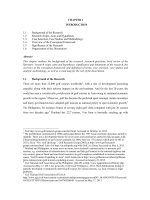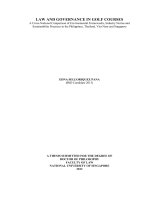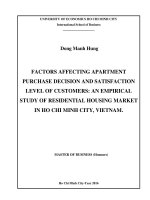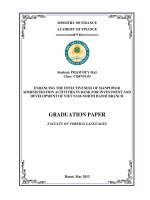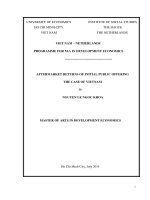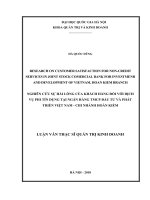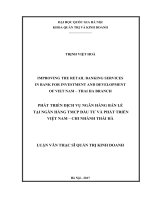- Trang chủ >>
- Sư phạm >>
- Quản lý giáo dục
Universities as driver of the urban economies in asia the case of viet nam
Bạn đang xem bản rút gọn của tài liệu. Xem và tải ngay bản đầy đủ của tài liệu tại đây (278.53 KB, 37 trang )
WPS3949
Universities as Drivers of the Urban Economies in Asia:
The Case of Vietnam
Tran Ngoc Ca1
National Institute for Science and Technology Policy and Strategy Studies
Abstract
This study looks at the contribution of the university system in Vietnam to the
socioeconomic development in general, and their relationship with firms, dynamic actors
of the economy in particular. The study uses different methods of research, from reliance
on secondary data to interviews with universities and survey of firms. Several case
studies of the key universities in four regions have been undertaken: Hanoi in the north,
Danang in the center, and Ho Chi Minh City and Cantho in the south of Vietnam. The
findings show that the role of Vietnamese universities in research is much weaker than
teaching, and that their contribution to the socioeconomic development of the country is
limited to the production of an educated labor force rather than innovation. However, in
selected universities, innovation did take place to a certain extent and brought benefits for
both the universities and firms they served. This situation is explained by both the
inheritance of the previous build up of the university system in Vietnam and its shift in
behavior in the context of economic renovation and globalization.
World Bank Policy Research Working Paper 3949, June 2006
The Policy Research Working Paper Series disseminates the findings of work in progress to encourage the
exchange of ideas about development issues. An objective of the series is to get the findings out quickly,
even if the presentations are less than fully polished. The papers carry the names of the authors and should
be cited accordingly. The findings, interpretations, and conclusions expressed in this paper are entirely
those of the authors. They do not necessarily represent the view of the World Bank, its Executive Directors,
or the countries they represent. Policy Research Working Papers are available online at
.
1
With collaboration of Le Van Chuong, Nguyen Phuong Mai, Nguyen Do Anh Tuan, NISTPASS.
The authors also would like to thank staff of universities and firms for providing data and interviews.
1
INTRODUCTION
In an effort to achieve the Millennium Development Goals (MDGs), the
Vietnamese government has assigned high priority to education (UNDP, 2003), including
at the tertiary level. Previous studies of the impact of universities in Vietnam have
focused primarily on their role in generating income and jobs through their own and their
students’ expenditure within the regions where they are located. However, the potential
impact of universities is not limited to these backward linkages: there are potential
forward linkage effects as well. These include the supply of skilled workers, but also
industry-university research collaboration and consultancy services for local firms. In
Vietnam, the extent that business-university collaboration has benefited local (urban)
economies in general, and firms in particular, has not been studied in sufficient detail.
This article situates the role of universities in Vietnam's development in the
context of increased challenges and opportunities brought about by globalization. The
study examines the characteristics of universities and the context that shapes their roles;
the current extent and modes of collaboration between universities and firms; and
institutional barriers hindering ties between universities and firms.
We find that
Vietnamese universities have contributed significantly to the development of local areas,
though for the most part this has been through the supply of human resources rather than
through job creation or the creation of new enterprises.
Our findings result from a review of secondary literature, interviews with
Vietnamese firms and selected case studies devoted to the policy and institutional
environments in Vietnam. The next section of the article provides an overview of the
2
Vietnamese context and the role of universities in the country's innovation system. Case
studies of four universities are then provided in order to offer a more comprehensive
picture of variation across specific contexts. The article concludes with consideration of
policy interventions that could encourage universities to make greater contribution to the
Vietnamese economy’s competitiveness in the global market.
VIETNAM’S INNOVATION SYSTEM AND THE ROLE OF UNIVERSITIES
To map the context in which universities operate, it is useful to provide an overall
picture of Vietnam's economy in general and innovation system in particular. Vietnam is
experiencing multiple challenges of globalization: it must increase the competitiveness of
its economy and pursue industrialization and modernization while joining international
economic institutions and regimes. Thus, the country is undergoing a double transition,
from a planned economy to a market-oriented system and from an inward-orientation
toward greater regional and international economic integration. Vietnam remains an
agricultural economy and society, with three-fourths of the population living in rural
areas and two-thirds of the labor force still working in an agricultural sector characterized
by low productivity. Economic backwardness and weakness are revealed by very low
levels of efficiency and competitiveness.
The structure and characteristics of the economy shape the kinds of knowledge,
technologies and R&D activities needed to upgrade production capabilities. Models of
university-industry linkage (UIL) should therefore be examined in close interaction with
local context.
3
At the same time, changes in the policy and market environments
influence the behavior of universities and the extent of their interaction with firms. As
our case studies demonstrate, these shifts tend to be location specific rather than generic.
It is worth noting that until recently both state enterprises and private firms have
experienced limited need for technology innovation due to a longstanding absence of
competitive pressure. Largely for this reason, the R&D and learning capabilities of firms
have been weak.
It has been difficult for economic actors to link to knowledge
institutions to develop joint research activities or product innovation. The sole exception
is in the few industries, such as telecom and energy (oil and gas, power generation),
where the rate of innovation is higher and relatively high levels of investment resources
are available.
Vietnamese exports began with basic primary products like rice, shrimps and
cashew nuts, and have moved gradually to manufactured goods such as textiles,
garments, footwear and electronics. This shift requires manufacturing technology that
can help firms in dealing with quality and other technical standards of international
markets. The abolition of trade protection in the framework of regional agreements such
as the Association of Southeast Asian Nations (ASEAN), the Asia Free Trade
Association (AFTA),
and the BTA will lead eventually to the same competitive
conditions for the domestic market.
Certainly, both training and R&D provided by universities have to serve the
production needs of firms. By all accounts, the inadequate supply of a skilled labor
force is an especially urgent matter. Local enterprises often complain about the
difficulties in finding enough skilled labor force for their production activities (Pham
Minh Hac, 2000), and the traditional mandate of universities in Vietnam is to
4
produce human resources rather than to engage in research.1 Although this mandate
has changed over the last decade, with more emphasis being placed on R&D, the role
of universities in the national innovation system arguably should be examined more
in terms of training than on advancement of innovation capabilities.
The
general
context of Vietnamese production points to the need for an innovation system and
universities capable of serving medium-tech firms. At the same time, universities
still have to carry on with the traditional mandate, that is, provision of labor force,
first for domestic enterprises and then for firms resulting from FDI.
Socio-economic transformations of the last 20 years have created an impetus for
changes in the higher education system in order to contribute to the creation of a new
generation of the workforce. Fees for training activities also have brought substantial
extra resources for universities. At the same time, many universities have begun to
overcome their old mode of operation, in which teaching was divorced from research, by
becoming involved in R&D projects and pilot production. Between 1991 and 1996,
universities undertook nearly 200 pilot production projects relying on their own research
results and contracting systems. From 1996-2002 universities implemented 3,800 R&D
projects and were involved in 90 pilot production projects. By the end of 2002, the
university system encompassed 167 research divisions and 147 centers dealing with
technology development and consulting activities.
As depicted in Table 1, however, the bulk of R&D activities are conducted not in
universities but in research institutes under line ministries and in two national research
centers devoted to natural and engineering sciences and social sciences 2. There is very
modest financing of R&D via the state budget: Vietnam spent around 0.5% of its GDP on
5
R&D in 2003 (Asian Productivity Association, 2003), whereas in most OECD countries
and China around 2% of GDP is devoted to this purpose. Moreover, most publicly
funded R&D is conducted in government research institutes. Only a limited number of
university faculties have adequate resources for significant R&D.
The research
infrastructure is below international standards, and what research is being carried out
tends to be theoretical, supply-driven, and not connected to the needs of the productive
sector. The national R&D system is "organized, financed and managed in such a way that
technology transfer is difficult and expensive" (Bezanson et al., 2000).
Table 1: R&D Personnel Comparisons in 1990-2001
R&D
R&D personnel
Country
Personnel
GDP
Population
(billion USD)
(millions)
per 1 million
per billion
people
USD of
GDP
Vietnam 274
35.1
80.3
629
China
584
1,266.1
1,294.9
597.3
Korea
2,880
476.7
47.4
286.4
Source: Calculated from UNDP Human Development Report Statistics 2004,
/>
According to MOET data, in 2000 Vietnam had 77 universities and 114 colleges,
housing 160 institutes and research centers. Total teaching staff was 55,887, of which
35,938 were lecturers with university degrees and above. Until the beginning of 2003, the
6
country had two national universities, three regional universities (with 20 university
members), 76 independent universities and academies and 119 colleges. Among these,
there were two semi-private and 16 private universities, and four semi-private and three
private colleges. During academic year 2004 – 2005 the number of universities and
colleges had grown to 230 (93 universities, and 137 colleges) (MOET, 2005). Tertiary
education gross enrollment was 8.6% in 2001, up from 1.5% in 1992 and a total of 1.3
million graduates have attended technical training institutes3.
Over the last few years, the infrastructure and facilities of the university system
have been upgraded significantly. Some laboratories have reached the regional standard.
The system of electronic libraries and electronic communication networks such as LAN,
have been strengthened, and websites have been set up. Expenditure for the R&D
activities of universities is about 4% of total investment for national science and
technology. Apart from the government budget, which satisfies about 50% of the need for
science and technology activities, many universities have been contracted by other
organizations and received non-government sources of funding: 29.2% from enterprises;
6.7% from other organizations and 48.8 % from international sources.
FIRMS AND UNIVERSITIES: DEMAND VERSUS SUPPLY
Looking at firms, there is a mixture of various kinds of actors in the
Vietnamese economy. A majority of local firms are still small and medium
enterprises (SMEs). In an innovation survey (Nguyen Vo Hung & Nguyen Thanh
Ha, 2004) covering the mechanics and food processing industries, a majority of firms
reported having innovation ideas from their own activities (82.4%) and from
7
suggestions of customers (58.8%). These innovations are not significant or
breakthrough in nature but rather incremental and minor. With this type of
innovation, the supplier-producer-customer linkage is more important for technology
learning than is the linkage with public institutions such as R&D institutes.
If the small firms tend to have innovation ideas from their own activities and
customer suggestions, big firms like state corporations under key ministries seem to
have a more diversified source of ideas for innovation. Public institutions such as
R&D institutes and tech-info centers play a limited role in the learning activities of
these firms. Instead, cooperation with domestic, foreign and FDI partners are
considered important channels to address problems that firms face in the innovation
process. The aforementioned innovation survey found that 71% of SMEs and 93% of
non-SMEs in the mechanics sector reported having relationships with foreign/FDI
firms. This means that large corporations usually have more resources for innovation
and R&D and a larger window for learning than SMEs have.
Many obstacles and disincentives prevent or discourage SMEs from
developing innovation capabilities, and the limited amount of innovation that does
take place in SMEs is concentrated in process development and quality control.
Firms do not have sufficient resources for long-term investments, including
recruitment of highly skilled labor and equipment to innovate. Technical services
are unavailable to small firms, which typically lack information on available
technologies.
Market barriers are also high, as SMEs are unaware of product
requirements and distribution channels. Finally, "SMEs have a hard time obtaining
credit from banks due to a lack of collateral assets and because of the complicated
8
procedure of getting credit" (Bezanson et al., 2000). Moreover, private enterprises
are at a disadvantage as compared to SOEs, due to their lack of access to both
preferential and non-preferential government loans. They must rely on their own
capital resources for R&D.
Figure 1 R&D Source Distribution in Enterprises in 2002
R&D Source Distribution in Enterprises in 2002
100%
90%
other resources
80%
70%
own capital
60%
loans from preferential
government treatment
loans not from preferential
government treatment
government
50%
40%
30%
20%
10%
0%
total
statenon-state
foreign
enterprises enterprises enterprises
Source: General Statistics Office 2004
Although a range of studies4 have pinpointed a need by firms for technological
services for innovation, this is not met at this juncture by R&D organizations and
universities. The situation is much worse outside of Hanoi and Ho Chi Minh City, where
there is complete lack of supply for some services (Miehlbrandt, 2002).
Among research institutes and universities, the share of cooperation with
enterprises is low. As depicted in Table 2, a survey of linkages between R&D institutes,
universities and industries reveals that universities are doing even less cooperation with
firms than research institutes are.
9
Table 2. Contracts with enterprises per total projects and funding
Research
Share in number of
Share in value of
research projects
research funding
(%)
(%)
17
35
6.1
28
Institutes
Universities
Source: NISTPASS, 2000
FDI firms are strongly concentrated in the manufacturing sector, chiefly in light
industries. Few investors are in service industries and at this stage there is little FDI in
high-tech sectors. Regardless of the extent to which FDI has accounted for technological
advancement of local industries, it is the general consensus that S&T institutions have not
done much to support these gains. NISTPASS (1997) observed that the production sector
considers that S&T institutions cannot provide necessary support for their production
problems. NISTPASS (2000) also found that S&T institutions had few contracts from
the production sector in the period from 1995 to 1998, and that the type of contracts that
did exist were small scale, simple and low-risk in nature.
As we can see from this section, different types of firms exhibit different behavior
and extent of engagement with regard to innovation. The SME sector in general is weak
and sources its R&D externally, relying little on R&D institutions and universities. Large
corporations are in somewhat better position to do the same. FDI firms tend to rely on
10
their home country R&D organizations. Taken as a whole, what this suggests is that
there are few opportunities for Vietnamese R&D institutions and universities to play a
significant role in helping firms, and even when they do, these activities involve mainly
incremental and minor technical change.
If the demand side is limited, it is not surprising that universities’ share in R&D
supply is not high. In terms of infrastructure and other teaching and R&D facilities,
although there is some investment for upgrading lately, this tends to be restricted to the
largest universities. Many universities still use equipment and facilities in place since the
mid-1960s or 1970s. Libraries in many universities are small, outdated in both quality
and holdings. Foreign languages literature is still mainly in Russian, dating back to the
mid-1970s. Even for those universities with access to English language literature, the
rate of use is minimal due to low English capability of the staff and overload of teaching.
As a result, teaching curricula are old, repetitive and lacking in innovative approaches
and new knowledge. Moreover, there has been a lack of electronic links with a national
library or central information and librarian system.
On the training side, enterprises rely on unskilled and semi-skilled labor and
maintain low productivity levels. Enrollment in vocational institutions is low or consists
of short-term training, while informal education plays an important role in acquiring
skills (UNIDO, 1999). Many firms are able to maintain or improve production in export
markets by investing in training their workforce, yet most staff training focuses on shortterm needs. Firms do not train staff at higher technical levels due to a lack of resources
and the risks involved in losing staff to competitors offering better working conditions.
Although Vietnam has a high literacy rate (94%) through its implementation of near11
universal primary education and its long tradition of learning, access to technical training
and higher education institutions has been limited, and the skill level of the workforce is
insufficient for technology development. Universities in general are mandated mainly to
produce students, but all too often their graduates lack practical expertise. Data from the
aforementioned empirical study also reveal information concerning the status of linkages
between R&D, postgraduate education and the needs of the economy and the production
sector (NISTPASS, 2000):
•
Universities contributed actively to the training needs of the society and economy.
However, direct service to enterprises has been insignificant.
•
There is an enduring imbalance between the subject of study and firm needs. Most
postgraduate students are in social sciences and humanities, while those subjects
closer to productive activities -- like engineering or agro-forestry sciences and
technologies -- remain comparatively underdeveloped.
•
The majority of organizations sending their staff for university training consist of
government agencies, whereas very few programs result from the needs of
productive enterprises.
•
Links between industries and research institutes are not close. There has been lack
of a system of brokerage organizations to deal with bridging R&D and production
activities. Coordination of research activities between R&D institutes and
enterprises is very weak or almost absent.
•
Research capability of enterprises is very weak and negatively influences the
development of university-industry linkages.
12
This situation is related largely to problems faced by the current R&D system.
Most Vietnamese universities are not perceived as centers of R&D excellence. They lack
autonomous status, and despite the fact that their operations have been increasingly
independent, they still receive many directives from above and operate under regulations
of MOET. Especially in public universities, staff faces constraints in terms of salary
ceilings, human resource management regulations and financial incentives. Basically,
they are still seen as government officials rather than as academics.
Lack of macro incentive regimes has discouraged motivation and dynamism for
teaching staff in universities. There are no incentives encouraging them to interact with
other institutions and the firms. To date, cooperation between university staff and units
outside the university system has been short term, based mainly on personal and informal
connections.
Besides training of a higher-skilled labor force, the contribution of
university activities as such tends to be of a one-off nature. In the existing system,
universities do not see technology transfer activities as crucial for their existence and they
are not very attractive to the firms as a source of innovation and new knowledge. In
many instances, technology facilities and innovation rates in universities are substantially
behind those of firms.
Concerning human resources for teaching, the number of professors and lecturers
is inadequate given the number of students5. Between 1995 and 2005, for instance,
student enrollment increased 4.43 times (from 297,900 to 1,319,754 students), while
teaching staff increased by less than half that amount (from 22,750 to 47,616 lecturers)6.
Given this overload of teaching, there is little time for staff to engage in research and
technology development or other learning activities. Teaching staff in Vietnamese
13
universities reflect a generalized problem of ageing throughout the science and
technology system. The majority of full and associate professors are above 55 years old,
and there are insufficient replacements in the pipeline. This is likely to lead to a
generational gap in human resources of the university system in the near future.
Notwithstanding isolated exceptions, there has been no entrepreneurial spirit among
academics working in universities. The most entrepreneurial character so far is reflected
in the desire of teachers to do “outside the class” teaching to earn extra money. This is
explainable by the low base salaries of academic staff and their need to earn second or
third incomes through various teaching and consulting assignments.
As seen in this section, the linkages between universities, research institutes and
enterprises in general, and between universities and firms in particular, still face many
hurdles that undermine university attempts to better serve the needs of the local
economies where universities are located. The view from firms, reflected in various
surveys, confirms that there is a demand for technology and training services provided by
R&D institutes and universities. However, the demand has been hardly met, and the
extent of relationship of firms with universities is less than satisfactory. In this context,
the contribution of R&D and training institutions in general and of universities in
particular is below the desirable level.
CASE STUDIES OF FOUR UNIVERSITIES
HANOI UNIVERSITY OF TECHNOLOGY (HUT)
Hanoi University of Technology (HUT) was established by government decree on
March 6, 1956 as the first university of the Democratic Republic of Vietnam. Today
14
HUT consists of 14 faculties and 25 institutes and centers. It has 1,800 staff, including
1,500 lecturers and 240 professors and associate professors, 450 of whom possess
doctorates. The university annually enrolls 35,000 undergraduate and 2,000 graduate and
postgraduate students. With teaching as its core mandate, skills development constitutes
the main type of cooperation between HUT and local enterprises. The HUT gives support
to firms through training and re-training of staff and upgrading of technological expertise.
Contracts for technical services and other R&D activities for firms represent another kind
of university linkage with industry, and HUT also provides firms with consultancy
services on technology innovation and equipment upgrading.
To develop outreach to local enterprises, the university has created several
incubators for technology and business development. Funding for R&D comes from
three main sources: the state budget for programs and projects, the business sector
through contractual arrangements, and international organizations via development
assistance. In general, however, the quality of research in HUT is still low, and research
projects are seldom linked to needs of the productive sector.
Yet in some cases technology transfer from HUT to local organizations has been
noticeable. In a range of engineering subjects, such as new material technology, polymer
and composite technology for electrical, electronics and bioengineering, HUT has been
doing research to create applications in such fields as transport, agriculture, aquaculture,
environment protection, telecom, automation and power generation. Interestingly, it is a
policy of the HUT not to encourage staff to work individually with outside firms.
Instead, HUT has set up a company, Polynco, as a centralized commercial arm of the
15
university to deal with all technology transfer needs. Today Polynco is self-financing, and
earns income from technology transfer contracts.
A number of policy and legal provisions have been designed to promote creation
of companies from within the university. These are excessively vague, however, and
regulations for implementation are not in place.
The absence of communication
mechanisms is another obstacle to strengthened linkages between university and
companies. There is no system of match making or brokering to bridge the gap between
the technology that the university has to offer and the needs of firms that are potential
users of that technology. The government is working on the development of technology
market mechanisms7 by creating technology transaction floors in selected cities or
Techmart. Post-techmart supporting measures have been undertaken to follow up sales
and transactions. So far the initial costs for organizing these events are covered by the
MOST from its S&T central budget. In the near future, the newly established National
Science and Technology Foundation may cover a portion of the expense for this activity.
This move has facilitated quite actively the linkage between research institutions like
HUT and local firms.
Apart from policies promoted by central government, Hanoi city itself seems to
have less initiative and dynamism. The city office of the Department of S&T has
launched some programs to develop technology markets, but with little impact on
innovation and without success in fostering closer collaboration between HUT and firms.
Where relationships with firms exist these derive mainly from the highly entrepreneurial
leadership of HUT, which has set up its own firms to deal with technology
16
commercialization and tends to use its own connections with people in the central
government rather than in the Hanoi government.
Another issue on the municipal agenda is setting up a Hanoi high-tech zone. A
consultant group had recommended that the focus should be put on existing strengths of
HUT in Dai Co Viet street (where the HUT campus is located), in an effort to turn it into
high-tech corridor. But this proposal did not receive significant attention. Instead,
another corridor was set up to the northwest of Hanoi, with investment from foreign firms
leading to the creation of the Hanoi International Technology Center (HITC).
Subsequently, the central government decided to set up a large (national) high-tech park
in Hoa Lac, about 40 km west of Hanoi. The lack of coordination between central and
municipal authorities has impeded somewhat HUT's efforts to become a hub for
innovation in the city.
DANANG UNIVERSITY OF ECONOMICS AND BUSINESS ADMINISTRATION
(DUEBA)
Danang University of Economics and Business Administration (DUEBA) is one
among five universities and colleges belonging to the Danang University. The total staff
of DUEBA is about 200, with 8 faculties, offering training in various subjects in
economics. Undergraduate enrollment is approximately 3,000 per year, while the number
for graduate and post-graduate students is around 150. In addition, the university also
conducts part-time training programs. A majority of students come from the Center
region and 40% come from Danang City itself.
The most important contribution of DUEBA is being a hub for training human
resources for the local region. The university also supplies training services for high17
level local administration. In particular, the university prepared and imparted two-thirds
of the courses in the training program for firm directors, which was organized by Danang
City as part of a national program run by a consortium of all economics and business
administration universities. About 50-60% of university graduates work in Danang and
neighboring provinces, 10-15% in HCMC, and 10-15% in the Central Highland located
to the west of Danang City.
DUEBA also supplies contract-based training, consulting and other services to
enterprises and other organizations in the city and region.
In cooperation with the
Mekong Project Development Facility (MPDF), an IFC run program to develop private
entrepreneurship for the Mekong region, the external training unit of the university is
responsible for operating the “Management Development Program,” an initiative which
aims to help SMEs to hone their management skills and expertise. In addition, DUEBA
encourages its staff to cooperate with firms through management consultancies, attention
to legal problems, etc.
Apart from training, the university does some research with funds provided by the
city to meet local needs. These have included, for example, development of a master
plan for tourism in the region and a project to promote a tourist road in the Center region.
This source of finance accounts for about 10% of total research funding for the
university. Other DUEBA research projects are funded by the Ministry of Education and
Training.
Some large enterprises in the region, like the Danang Electricity Company, have
been long-term and close partners of the university. Interestingly, the university does not
require any financial contribution from staff working on contracts with firms, but in some
18
cases creates favorable conditions (like reducing teaching workload) for them to
implement contracts with firms. A total of 132 projects have been implemented by the
university over the last few years, of which 68% were for outside contracts. In addition,
firms improve their management capability via various training workshops and seminars
on policy and market analysis subjects. In 2001, to formalize its support for firms,
DUEBA created the Center for Consultancy and Enterprise Support. In addition to
consultancies, the Center supplies tailor-made training programs, organized on an annual
basis, for firms working in industries such as brake-manufacturing, oil and gas, airline
services, environmental management, coffee, leather and shoes.
Generally speaking, however, the linkages between DUEBA and local firms are
still limited. There are several factors influencing this process. Conventionally, DUEBA
always regarded teaching as its most important mandate. Other activities are deemed less
important and to a large extent are being neglected. Moreover, with a large number of
students in full-time training courses, sideline training activities for firms tend to emerge
only on an occasional basis. The firms themselves do not have great confidence in the
capability of the university system to support technology transfer8. Furthermore, in the
context of weak competitive pressures, not all firms in the region face the urgent need for
innovation and learning. Yet, with increasing competition coming from international
integration during the last few years, more firms are recognizing the need for innovation
and technology upgrading.
With regard to the policy environment, the DUEBA lacks funds for further
commercializing research results or doing pilot projects. In general, no entrepreneurial
culture has existed in the university, and DUEBA shows some resistance to engagement
19
with outside business. Given these factors, and the needs of the local economy, DUEBA
tends to stick to teaching activities.
Local government has created some favorable policy frameworks for linkages
between the university and firms. The Danang City authority is well known for its
openness and dynamic leadership. GDP growth of the city is well beyond the average
nationwide and the city has become a hub for attracting domestic and foreign investment
as well as for heritage tourism. Taking advantage of these circumstances, city leaders
launched a strong campaign to turn the city into an ideal environment for attracting
business and investment, emphasizing the lack of crime as well as the city's cleanliness
and good governance. The city allows and indeed encourages universities to recruit new
and young talent from all over the country, providing special material incentives like
housing and special financial packages, including salary rates above the regulated ceiling.
By doing this, the city has kept its own talent at home, and even attracts new people from
other big cities like Hanoi or Ho Chi Minh City.
Danang City's Department of Science and Technology (DOST) has received
financing from both the MOST and the city government to carry out various technology
application programs. DOST calls for strong support from DUEBA staff in providing
business skills for enterprises, which are cooperating with DOST in applying new
technology.
Several initiatives have been taken by the city government to spur
innovation and facilitate the use of the knowledge pool created by its local university.
The city plans to set up a technology and incubator system, building on the experience of
the last five years during which Danang Software Park has been in operation, attracting
20
more cooperation from the university. For DUEBA, entrepreneurship training programs
initiated by the city government are beginning to have positive effects.
HO CHI MINH CITY UNIVERSITY OF TECHNOLOGY (HCUT), UNDER
HCMC NATIONAL UNIVERSITY
Ho Chi Minh City University of Technology (HCUT) was established in 1957.
Today it features five faculties and many centers, with a total staff of 1,112, including
441 lecturers (of whom 51% hold postgraduate degrees), and 46 professors and associate
professors. Full-time student enrollment increased from 2,350 in 1999 to 4,138 in 2003,
while part-time students totaled 1,061 and 1,111 respectively.
The most important contribution of HCUT is still in training of human resources.
In addition to its mandate to train students, HCUT has a Center for Research and Training
Support in Business Administration, and a Consulting Office for Enterprises to link the
university with firms and other organizations in the entire country. Both of these entities
aim to impact the local economy through multiple channels, including:
1. Educating the workforce at various levels (engineers, workers, technicians),
including some opportunities for postgraduate training.
2. Design and orientation of new industries via projects or programs suggested
by cities and provinces.
3. Solving specific technical problems of production and business operation in
firms, technology transfer and services.
21
4. Supplying various kinds of consultancy services in R&D, testing,
standardization, metrology, quality control, and other technical solutions.
HCUT conducts those activities based on agreements with firms to implement
cooperative programs and projects, or on close relationships with business associations
such as the Plastics Association, Automation S&T Society, Mechanics Society, and the
Association for Leather and Shoe Industry. Many large-scale state-owned enterprises in
such industries as garments, plastics, mechanical engineering, construction, brewery, or
seafood processing have become long-term partners of HCUT and benefited substantially
from this partnership. One important feature of HCUT is its close collaboration with
many foreign companies operating in Vietnam. As a first step toward joint R&D
activities, a number of Japanese companies have collaborated with faculty of mechanical
engineering, assisted in some equipment and training in design, or computer engineering
in research to develop CAD/CAM software.
HCUT has a shareholding company - BackKhoa construction - to act as the
commercial arm for its research and training in selected areas. The annual state budget
for R&D and pilot industrial production was about 10 billion VND (around US$700,000).
In the meantime, earnings from technology transfer was 55 billion VND (US$3.6
million)9. To serve the needs of not only HCMC but also of the Mekong River Delta,
HCUT staff is involved in many research projects specifically aiming at the need of the
delta.
HCUT is located in Vietnam's most dynamic region of business and the university
staff have this advantage in applying new knowledge for economic purposes. The
university maintains close relationships with local firms and other organizations, and as a
22
result has contributed significantly to production and business activities in HCMC and
other provinces in the Mekong River Delta. Most projects for technology transfer are
related to agriculture production.
So far, the policy environment is not sufficiently conducive to facilitate
technology transfer and market transactions between universities and their potential
clients. Inconsistent and contradictory policies and institutional frameworks still create
difficulties for universities and firms to work together. Overall management mechanisms
for R&D and IPRs provide little incentive for university staff to work more closely with
firms. The establishment and operation of a technology transfer office or other forms of
commercial units within the university system so far is not a widely accepted practice and
depends on the initiative of each university. Lack of support in terms of funding, training
and connection for this necessary institution tends to slow down interactions between
universities and others actors. The role of individual scientists, inventors, managers and
entrepreneurs has so far received inadequate attention. The lack of an entrepreneurial
culture in the university system is a key constraint limiting the contribution of university
entrepreneurs to business operations.
Nevertheless, local government is quite active in promoting technology transfer
and enhancing the role of the university. The Ho Chi Minh City leadership is the most
dynamic among local authorities in Vietnam in creating a supporting mechanism for
innovation in research institutes, universities and their links with industry. The city has
set up a university council with the participation of many leading research institutes,
companies and universities to give advice on how to promote training and innovation,
and for linking them closer to the needs of urban development. The city creates programs
23
for linkage, enhancing the triangle of “enterprises-local government-university and
research institutes,” and this supports design, manufacturing, and production of new
technology for the modernization of key industries. To assist firms, the city attracts
university staff to work in newly established centers of excellence. For example, it
created a center called Neptech as a hub to design and manufacture new technology for
firms. The city government in coordination with its Department of Science and
Technology has introduced an action plan, “Program 04,” to develop new technologies
appropriate for its needs at reasonable cost, mainly relying on the efforts of domestic
research and innovation organizations. The program has been a powerful impetus for
HCUT to collaborate with enterprises. Another initiative has set up a list of the so-called
key products for the city and mobilized resources of research institutes, firms, universities
and associations in a concerted effort to produce these goods. The leadership of HCMC
authority has introduced significant measures to strengthen enterprise performance and
connections with universities working in the city. In fact, many other provinces and
cities now are studying this model carefully in an effort to replicate its success.
CAN THO UNIVERSITY (CTU)
Can Tho University was established as Can Tho Academy on March 3, 1966 with
a mandate to work in such fields as agriculture, veterinary medicine, irrigation,
agricultural mechanical engineering, and agriculture economics. The main functions of
the CTU are undergraduate, graduate and post-graduate training, as well as research and
technology transfer for the Mekong River Delta. Currently, the university has seven
24
faculties, three research institutes and three centers with 1,100 staff, of which 735, or
68.7%, participate in teaching and R&D activities.
During the period 1985-1992 the university launched a series of new science and
technology centers to promote linkages with development in the delta. Annually, CTU
receives about 21 billion VND (US$1.4 million) from various sources for scientific
research and technology development activities. CTU benefits from extensive networks
that facilitate cooperation with international associations, societies and firms around the
world. This helps the university upgrade its infrastructure, facilities, capabilities and
knowledge base, and has given rise to various fellowship exchange programs. CTU has
27 cooperative projects with foreign and international organizations, the budget for which
totals roughly $6 million.
Concerning its main training mandate, CTU is the sole university in the Mekong
River Delta and has made crucial contributions to skill development not only for Cantho
city, but also for all provinces in the region. Since the 1980s, the university has forged
partnerships with provinces in the Mekong River Delta to organize part-time programs to
provide university degrees in almost all provinces. In 2004 no fewer than 6,000 students
graduated, a majority of whom specialized in applied sciences aimed at serving the needs
of farmers and agricultural production in the region. The number of graduates at the
master’s level increased as well, nearly doubling from 44 in 1996 to 82 in 2004. Most
master’s students are staff of local government organizations, research institutes,
universities, and enterprises in the region, and their research has focused mainly on issues
concerning the socio-economic development of the region. These encompass fields such
as agriculture, forestry, aquaculture, veterinary medicine, biology and environmental
25

